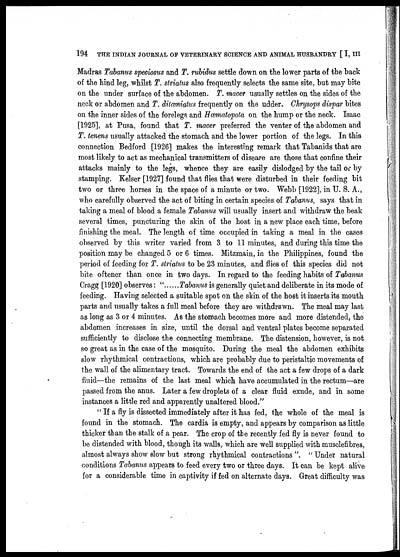Medicine - Veterinary > Veterinary colleges and laboratories > Indian journal of veterinary science and animal husbandry > Volume 1, 1931 > Part III (September 1931) > Veterinary entomology for India, Part XIV
(241) Page 194
Download files
Individual page:
Thumbnail gallery: Grid view | List view

194 THE INDIAN JOURNAL OF VETERINARY SCIENCE AND ANIMAL HUSBANDRY [ I, III
Madras Tabanus speciosus and T. rubidus settle down on the lower parts of the back
of the hind leg, whilst T. striatus also frequently selects the same site, but may bite
on the under surface of the abdomen. T. macer usually settles on the sides of the
neck or abdomen and T. ditæniatus frequently on the udder. Chrysops dispar bites
on the inner sides of the forelegs and Hæmatopota on the hump or the neck. Isaac
[1925], at Pusa, found that T. macer preferred the venter of the abdomen and
T. tenens usually attacked the stomach and the lower portion of the legs. In this
connection Bedford [1926] makes the interesting remark that Tabanids that are
most likely to act as mechanical transmitters of disease are those that confine their
attacks mainly to the legs, whence they are easily dislodged by the tail or by
stamping. Kelser [1927] found that flies that were disturbed in their feeding bit
two or three horses in the space of a minute or two. Webb [1922], in U. S. A.,
who carefully observed the act of biting in certain species of Tabanus, says that in
taking a meal of blood a female Tabanus will usually insert and withdraw the beak
several times, puncturing the skin of the host in a new place each time, before
finishing the meal. The length of time occupied in taking a meal in the cases
observed by this writer varied from 3 to 11 minutes, and during this time the
position may be changed 5 or 6 times. Mitzmain, in the Philippines, found the
period of feeding for T. striatus to be 23 minutes, and flies of this species did not
bite oftener than once in two days. In regard to the feeding habits of Tabanus
Cragg [1920] observes: "......Tabanus is generally quiet and deliberate in its mode of
feeding. Having selected a suitable spot on the skin of the host it inserts its mouth
parts and usually takes a full meal before they are withdrawn. The meal may last
as long as 3 or 4 minutes. As the stomach becomes more and more distended, the
abdomen increases in size, until the dorsal and ventral plates become separated
sufficiently to disclose the connecting membrane. The distension, however, is not
so great as in the case of the mosquito. During the meal the abdomen exhibits
slow rhythmical contractions, which are probably due to peristaltic movements of
the wall of the alimentary tract. Towards the end of the act a few drops of a dark
fluid—the remains of the last meal which have accumulated in the rectum—are
passed from the anus. Later a few droplets of a clear fluid exude, and in some
instances a little red and apparently unaltered blood."
"If a fly is dissected immediately after it has fed, the whole of the meal is
found in the stomach. The cardia is empty, and appears by comparison as little
thicker than the stalk of a pear. The crop of the recently fed fly is never found to
be distended with blood, though its walls, which are well supplied with musclefibres,
almost always show slow but strong rhythmical contractions". " Under natural
conditions Tabanus appears to feed every two or three days. It can be kept alive
for a considerable time in captivity if fed on alternate days. Great difficulty was
Set display mode to: Large image | Zoom image | Transcription
Images and transcriptions on this page, including medium image downloads, may be used under the Creative Commons Attribution 4.0 International Licence unless otherwise stated. ![]()
| Permanent URL | https://digital.nls.uk/75226517 |
|---|
| Description | Covers articles from 1931. |
|---|




